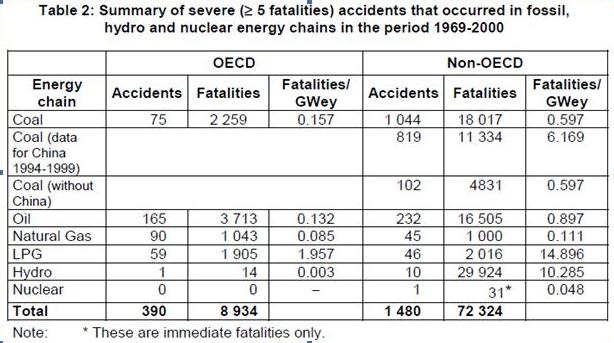Fukushima – why are we hanging our heads so low?
It has now been about two months since the horrific earthquake and tsunami that caused the damage at the Fukushima Daiichi Nuclear Power Plant. The people of Japan continue to suffer from this mind boggling natural disaster with the death toll at well over 20,000. And yet when we hear about Japan on the news it is the accident at the nuclear power plant that dominates the headlines.
The world has reacted. Countries like Germany are moving to abandon nuclear power in the disaster’s wake, Switzerland has halted its new build ambitions and Italy has stopped its movement away from a moratorium. In most other countries, there is continued support for nuclear power although there is a definite pause in new build as the lessons are learned and safety is re-evaluated.
Within the nuclear industry there are many who are crushed by this event; in fact no one is more disappointed and concerned about Fukushima than the industry itself. We have this tremendous ability for self criticism. We believe we need to suffer because of this and we know for certain that we need to do better. The IAEA is looking into how to improve safety at nuclear plants and I have seen numerous write ups suggesting a number of preliminary lessons learned. Some include placing backup generators at a higher level; others are looking to having a strategic power supply available for delivery to site within a short time frame after an accident as needed. For example, here is one point of view. Many of these ideas are quite good and I expect that the best of these will ultimately be implemented.
As engineers, we have a tendency to jump to solutions before we have the problem well defined. I hear almost every day people within the industry and elsewhere stating that “we need to improve safety”. However, what I do not see is anyone clearly articulating what we mean by that. Let’s discuss and identify the requirements of such a statement. Defining “improved safety” is the first critical step. Many of the suggestions so far will help with the next earthquake and tsunami but what about other unexpected events?
So let’s go back to the beginning. We had an extreme natural disaster that was well beyond that expected for this plant. At first the plant performed as designed but the tsunami was too much and many things went wrong. The natural disaster affected multiple units at the site and strained the ability of the workers to meet the needs of the plant to the extreme. Backup power was lost for weeks, not an assumption in the analysis. I’m sure that there will be many many other things that went wrong once the accident is studied in detail. And most of all, the plants are yet to be placed in a safe cold shutdown state and some radiation continues to be released.
Now let’s look at the consequences of this disaster. First and foremost, there has been no fatalities due to radiation; there has been no exposure either to workers or the public that have exceeded allowable limits (accepting that the limits for workers were increased to accommodate the accident). And while the evacuation zone is still in place, at this point it seems likely that there will be no long term contamination requiring moving people away from their home permanently.
That being said, I think we should all take a moment and be proud of our industry, proud that in the worst accident in 25 years, there are no immediate and no expected longer term fatalities. And that is what nuclear safety is all about.
So when we say we can we do better, what do we mean? We can’t have less than zero fatalities or less than zero excessive exposures. Going back to the requirements, I would say the two real issues needing improvement are the fact that there were releases, likely due to cracking in the containment structures – and this should not happen; and of most importance, the time to get the fuel cooling systems functioning and removing all of the decay heat is excessive. The fear caused to the public, and the subsequent reaction of governments may be the largest lasting impact. We need to set more strict guidelines for how to do better here and focus on reducing the time to cold shutdown following such extreme events. I am sure we can think of many other improvements in terms of reduced consequences and that should be a matter for further discussion before talking about fixes. It is interesting to see the IAEA revising their charting system for this event to focusing on three items: risk of criticality, long term decay heat removal and mitigation of radioactive releases.
Now while it is also useful to look at the many potential improvements to the plant designs to reduce the likelihood of such an accident, it would be imprudent to assume that some other event that we haven’t contemplated would ever happen. Hence one of the biggest lessons learned is that low probably events can indeed happen. And this means we need to review and see how to potentially make improvements in severe accident management.
But overall, I am hoping that at some point this event will be seen to have a number of positives. I can’t think of any other industry where the worst event in decades is one that results in no deaths. This is because this is what we expect of ourselves. Other energy industries don’t ever think this way. Accidents resulting in deaths are common place and readily accepted.
Source: Comparing Nuclear Accident Risks with those of other Sources – NEA 2010
This can be clearly seen in the above chart. Or as stated by Stewart Brand in his book “Whole Earth Discipline” – “Radiation from nuclear energy has killed not a single American, but of all these energy by-products, it is the only one we dread”
So why are we all hanging our heads so low feeling that we have failed. A 40 year old plant has survived a once in a lifetime natural disaster and the consequences to the public have been modest, mostly inconvenience and fear, but no injuries or deaths when the natural disaster that caused it has resulted in tens of thousands of deaths and a long lasting impact on the people of Northern Japan.
So as I see it there are two outcomes from an event such as this one. First as we would all expect, we will have many lessons learned so that we can make improvements in nuclear plant operation and safety.
But of equal or even more importance, perhaps this event will also demonstrate that even in what are perceived as very bad nuclear accidents, the consequences have a minimal effect on population health – and if we explain things correctly, we can demonstrate that even when these accidents happen, we can have confidence in their outcomes – and thus build confidence in the public that global catastrophe is not around the corner as a result of nuclear power and that indeed the industry is what we want it to be – SAFE.






1 Comment
Michael Dubreuil · May 10, 2011 at 10:16 am
Well balanced and well reasoned. In-deed there are lessons to be learned here. More importantly the nuclear Industry needs to stand up and put the accident into perspective against all the other alternatives.
Given the global warming crisis we face, the dwindling supplies of easy oil and naural gas, and the economics of green energy – The nuclear industry must gain some measured confidence and fight for the benifits it can deliver.
The promoters of the politics of fear are like the bully in the school yard, if we as an industry stand up to them they will move on to some other victum.
Comments are closed.